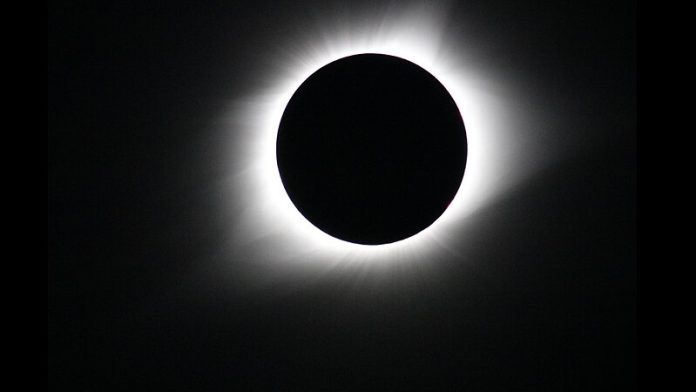Total solar eclipse will be observed in North America continent on Monday 8th April 2024. Beginning Mexico, it will move across the United States from Texas to Maine, ending in Canada’s Atlantic coast.
In the USA, while the partial solar eclipse will be experienced in the entire country, the total solar eclipse will begin at 1:27 p.m. CDT in Eagle Pass, Texas, cut diagonally across the country and end around 3:33 p.m. EDT in Lee, Maine.
The path of totality will be about 115-mile-wide covering a region inhabited by over 30 million people.
Total solar eclipse occurs when Moon comes between the Earth and Sun obscuring the Sun completely from view on Earth. It is an important astronomical event for the scientists and researchers for several reasons.
Corona, the outermost part of the Sun’s atmosphere, can be seen from the Earth only during the total solar eclipse hence such events offer researchers opportunity to study. Unlike photosphere, the visible layer of the Sun whose temperature is about 6000 K, the outer atmosphere corona gets heated to millions of degrees Kelvin. Stream of electrically charged particles emanate from the corona into space in all directions (called solar wind) and bath all planets in the solar system including the Earth. It poses threat to life form and electrical technology based modern human society including satellites, astronauts, navigation, communications, air travel, electrical power grids. Earth’s magnetic field provide protection against the incoming solar wind by deflecting them away. Drastic solar events like mass ejection of electrically charged plasma from the corona creates disturbances in the solar wind. Hence the imperative of study of corona, solar wind and disturbances in its conditions.
Total solar eclipses provide opportunity to test scientific theories as well. One classic example is observation of gravitational lensing (i.e., bending of star light due to gravity of massive celestial objects) during total solar eclipse of 1919 over a century ago which validated Einstein’s general relativity.
The sky has changed rapidly due to the commercialization of Low Earth Orbits (LEO). Given there are nearly 10,000 satellites in the orbit now, would this total solar eclipse reveal a sky full of satellites? A recent simulation study suggests that the high sky brightness during totality will make the brightest satellites undetectable to the unaided eye but the glints from artificial objects in orbit could still be visible.
***
References:
- NASA. 2024 Total Eclipse. Available at https://science.nasa.gov/eclipses/future-eclipses/eclipse-2024/
- National Solar Observatory (NSO). Total Solar Eclipse – April 8, 2024. Available at https://nso.edu/eclipse2024/
- Cervantes-Cota J. L., Galindo-Uribarri S., and Smoot G.F., 2020. The Legacy of Einstein’s Eclipse, Gravitational Lensing. Universe 2020, 6(1), 9; DOI: https://doi.org/10.3390/universe6010009
- Lawler S.M., Rein H., and Boley A.C., 2024. Satellite Visibility During the April 2024 Total Eclipse. Preprint at axRiv. DOI: https://doi.org/10.48550/arXiv.2403.19722
***




































